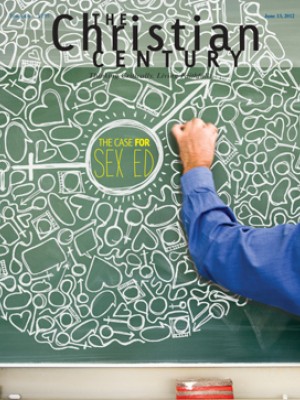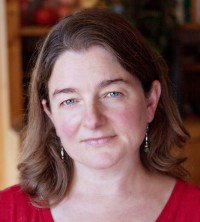Facts of life: The case for sexuality education

Read the sidebar article on church-based sex ed
When Chicka Merino, a sex education teacher in Minneapolis, gave me the chance to meet with one of her classes, I couldn’t resist asking the teenagers a question: What has been the most memorable part of sex ed for you? The first hand to go up belonged to a Somali-American girl in a gray hijab whom I’ll call Amina.
“For me,” she said, “it was probably the day when Chicka made us play with condoms. I’d never seen or touched one. We opened them up, took them out of their packages and blew them up like balloons. Then we tossed them around the room. . . . I learned that a condom is just a thing. I’m not scared of it anymore.”
Read our latest issue or browse back issues.
Amina continued: “I always thought that if I talked about sex, people would think I was having sex. . . . Or [I thought] that talking about sex is encouraging it. But it’s the opposite.”
Since I had been reading about the controversies over sex education, I could imagine how some uneasy parents or legislators might react to Amina’s story. Hearing about students playing with condoms might reinforce their worst fears about frivolous treatment of sexuality in public sex education. But when I heard Amina’s enthusiastic and articulate response to my question, the argument for comprehensive sex education seemed even clearer to me; Amina, armed with information and confidence about condoms, appeared to be in a better position to make informed decisions.
In fact, though sex education makes some people nervous, study after study shows that giving teens information about sex and engaging them in open conversations about issues of sexuality is effective. It helps reduce teen pregnancy and prevent the spread of sexually transmitted diseases. It helps them to analyze their own behavior and sometimes even to critique the culture that gives them bad or misleading information all the time.
In 2008, Douglas Kirby, a researcher with ETR Associates, a nonprofit consulting firm, reviewed 115 programs nationwide and concluded that comprehensive sex education helps reduce risky sexual behavior and that it is more effective than abstinence-only education—an approach in which methods of birth control besides abstinence are not mentioned (let alone played with). Kirby’s conclusions were corroborated by Mathematica Policy Research, which conducted a nine-year study of abstinence-only programs and concluded that teenagers who had studied under such programs were no more likely to abstain from sex than those who had not had such education. But it also found that teenagers who had had an abstinence-only education were not more likely to have unprotected sex, as some critics had claimed. Mathematica and Kirby’s studies are part of a broader attempt on the part of sex educators to undergird their work with comprehensive and rigorous studies, in part because of their field’s controversial nature.
A sort of schizophrenia seems to lie at the heart of American approaches to sexuality. On the one hand, movies, TV shows and advertisements are drenched in references to sexuality, and children encounter sexual messages at a very early age. On the other hand, many Americans are deeply anxious about addressing sexuality in public settings. In situations where genuine information rather than provocative advertisements might be useful, many people prefer to change the subject. The fear of controversy has prohibited many school districts across the country from implementing any kind of comprehensive sexual education program. “When it comes to sex education,” said Deb Hauser, executive director of Advocates for Youth, “fear of controversy plays a far greater role than actual controversy.”
But support for comprehensive education may be gaining ground. In January, the largest advocacy organizations, Advocates for Youth, Sexuality Information and Education Council of the U.S. and Answer, released the first-ever attempt to articulate national sex education standards for grades K–12. Hauser said that demand for these standards far surpassed her expectations.
“We’ve been hearing from school districts and departments of education all across the country. There is a hunger and a thirst to do better by our kids.”
Support for sex education has risen and fallen since Chicago high schools implemented the nation’s first program in 1913. Chicago school superintendent Ella Flagg Young argued that it is as “important for the growing child to know his own body as it is to know arithmetic.” But the program lasted only one year, and it spelled the end of Young’s career.
Through the middle decades of the last century, waves of social reformers argued for the importance of sex ed in the prevention of disease, but they gained little ground until the HIV/AIDS epidemic in the 1980s. That epidemic created a sense of urgency around sex education that led to the widespread acceptance of basic HIV prevention curricula in many states.
A movement for abstinence-only education arose in the 1990s, and Congress responded by providing federal funding only to programs that adhered to that approach. Many states—which generally don’t require schools to provide sex education—adopted “if-then” clauses in their education mandates: if a school district were to include sex ed in its curriculum, then it would have to use an abstinence-only approach.
The health-care reform legislation that President Obama signed in 2010 included what SIECUS calls “the first-ever, dedicated funding stream for comprehensive sexuality education.” This funding source, known as the Personal Responsibility Education Program, was intended to replace the Title V funding designated for abstinence-only education. However, Congress in 2010 reinserted Title V funds for abstinence-only education. Currently, states have the option to choose between PREP funds and Title V funds—or both or neither. In addition, organizations can participate in the president’s Teen Pregnancy Prevention Initiative, which provides $110 million in funding directly to community organizations, bypassing the states.
PREP funding requires teaching about both abstinence and other methods of birth control. It does not require schools to teach that sexual relationships outside of marriage cause “psychological and emotional harm,” as is required under Title V funds. PREP also does not require state matching funds, and for this reason alone states find it attractive. In 2010, 43 states applied for PREP funding and 30 applied for Title V funding.
But the wars over sex education are far from over. The announcement last summer that New York City will require sex education was met with an uproar from religious and political groups that want to keep it out of the schools entirely. And when Planned Parenthood of Greater Northern New Jersey held its 2010 sex education conference, it was met with demonstrators who objected to the presence of public school teachers at a Planned Parenthood event.
Opponents of comprehensive sex education generally have two concerns. One is their conviction that sex education in public schools undermines parents’ rights to teach their children about sex in their own manner. The other is that sex education can never be value-free and that it is likely to promote promiscuity. In an op-ed piece in the New York Times last fall, Robert P. George and Melissa Moschella expressed both of these concerns. Sex ed promotes “a certain sexual ideology,” they said, and it undermines religious and moral values taught in the home. “Should the government force parents . . . to send their children to classes that may contradict their moral and religious values on matters of intimacy and personal conduct?” Sexual education in any form, the authors argued, violates a “zone of sovereignty” that belongs to parents. (Because of concerns like these, nearly every program contains an “opt-out” for parents who do not want their children to receive sex education.)
Minneapolis, where Merino teaches, has never had a mandate regarding sexuality education. And the city has received little direction from the state, which has been involved in a tug of war over sex education. Every year from 2003 to 2009, the Democratically controlled Minnesota legislature included a comprehensive sexuality education mandate in its education bill, and every year Governor Tim Pawlenty threatened to veto the bill if that section was not dropped. In 2010, when both houses of the legislature were controlled by Republicans, the sex ed portion of the education bill did not even get this ritual reading. Pawlenty accepted Title V funds instead of PREP, infuriating many educators and youth health advocates statewide. When Democrat Mark Dayton took office, he accepted PREP funds.
Minneapolis, however, was already in the process of adding sexuality education to existing health classes in middle schools and high schools. That shift came as the result of a confluence of events. Minneapolis mayor R. T. Rybak had identified youth violence as an area of focus, and when he convened several task forces to study the issue, one task force came up with a recommendation for better, earlier and more comprehensive sex
education, beginning in middle school. Meanwhile, a loose configuration of nonprofit organizations, including Teenwise Minnesota, used the fact that the city’s health education standards were up for review to argue for a new sex ed program. Advocates decided not to press the school board for a mandate because they didn’t want to create a controversy. (Some evidence suggests, however, that opponents may be vocal but few in number. A 2007 survey by the University of Minnesota’s Prevention Research Center showed that upward of 89 percent of Minnesota parents support comprehensive sex education statewide.)
Merino, who’s been teaching about sexuality for 15 years, works neither for the city nor the state but for Lutheran Social Services of Minnesota. LSS contracts with public schools and other organizations to provide sex education. She often takes over a school health class for a few weeks, for example, or convenes small groups.
She said the battle between comprehensive and abstinence-only approaches frequently rests on faulty conceptions of youth development. “If we really understood the 14-year-old brain,” she said, “we would give kids every tool we could possibly come up with to [help them] make good decisions. The 14-year-old brain does not really grasp consequences and is not future oriented. . . . It is up to adults to be constantly getting them to think about consequences.”
Learning to make decisions about sex, said Merino, is a skill, like dribbling a basketball. “You don’t hand kids a ball and say, ‘Here’s a ball. You’ve seen it on TV.’”
For Merino, comprehensive sex education is a multifaceted affair. It is tied to teaching job skills, encouraging self-esteem and instilling media savvy and critical cultural awareness. If she could create the perfect sex education program, she says, it wouldn’t take place in a classroom; it would be an expanded version of her peer education program in which kids teach and learn from one another.
During the peer education session that I attended, the group of teenagers was focusing on what constitutes sexual harassment. Their approach was not clinical or legal, but instead intuitive. What is respectful communication? When does playful touch become unwelcome? The youths worked in small groups on lists of behaviors, categorizing them as acceptable or unacceptable. Then, as a group, they discussed their lists and noted that clear boundaries weren’t always evident. When does texting become harassment? What if you get a hug you don’t want?
Merino offered few answers. She seemed intent on helping the group develop a more innate sense of boundaries, even as she weighed in on what was clearly out of bounds and offered advice on how to respond to unwanted attention. (About an unwanted hug, she proposed the playful but skeptical, “I didn’t know we were hugging now.”)
One of Merino’s students was a 15-year-old sophomore whom I’ll call James. He told the group about an uncomfortable conversation he overheard in one of his classes. A boy was pestering a girl, using explicit language and referring to parts of her body. James couldn’t tell if the girl liked the attention or if it embarrassed her, but he knew that he didn’t like it. He though it fit the definition of sexual harassment, which the group had been discussing with Merino. He brought the situation to the group.
Merino challenged James: “Is there anything you would feel comfortable doing about the situation?” He decided that he would be willing to ask the girl if she liked the way the boy talked to her or not.
A few weeks later, James reported that he had spoken to the girl, who told him that she didn’t like how she was treated by the other boy. “I hate it. I am going to kick his ass.” When the boy came into the room and started pestering her again, she told him, “Stop it or I am going to kick your ass.” James didn’t think this was a suitable response, so he added his own words: “Hey, that really isn’t cool.” The boy’s response to James was negative, but James seemed unfazed. He reported his experiment in diagnosis and social intervention coolly, but with evident pride.
Merino’s colleague, Kirby Hagen, likens what James was learning about sex to learning how to dance. Information, in and of itself, is not enough. One has to be able to “apply information, seeing its value for you in your life. . . . When you are performing a dance, you need to know the dance so well that if you are walking down the street and you hear a note of the song, you can start to dance. That’s how it should be with comprehensive sex ed. It is not ‘Here’s a fact about HIV’ but ‘Here is a situation, how are you going to react?’”
Merino is confident that her teaching is effective, and she doesn’t necessarily need studies to prove it—although they do help her prove it to others. She has been at this work long enough that she sees her former students everywhere she goes.
“I went to a movie the other night and a kid leaned down from the balcony. ‘Hi, Chicka,’ he said. ‘I’m 22 now and no babies!’ My friends asked me, ‘Who was that!?’ But that happens all the time.”




